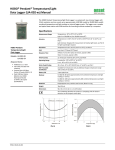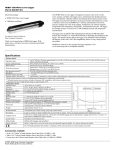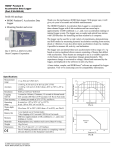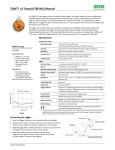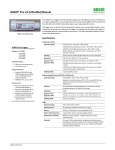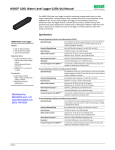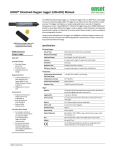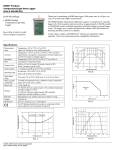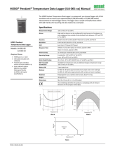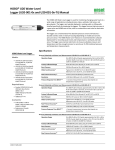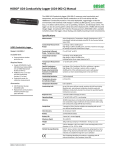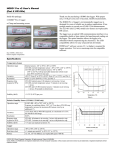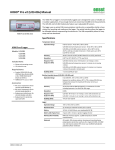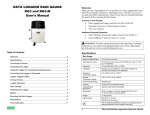Download Onset HOBO™ UA-003-64 User Manual
Transcript
HOBO® Pendant® Event Data Logger (UA-003-64) Manual The HOBO Pendant Event/Temp Data Logger is a rugged, weatherproof event logger with a 10bit temperature sensor. It is ideal for use with tipping-bucket rain gauges, and can record tens of thousands of measurements and events. The logger uses a coupler and optical base station with USB interface for launching and data readout by a computer. Specifications External Event Input HOBO Pendant Event Data Logger Event Sensor Two-wire interface suitable for measuring mechanical and electrical contact closures Maximum Input Frequency 1 Hz (1 pulse per second) Lockout Time 500 ms Minimum Pulse Width 1 ms (hardware debounce) Input/Output Impedance 100 kΩ Edge Detection Falling edge, contact closure, or Schmitt-trigger buffer Preferred Switch Type Normally open. For maximum battery life, the event input should be used with its preferred switch type. The logger will work with normally closed switches, but battery life will be compromised. Open Circuit Input Voltage Battery voltage; nominally 3.0 V Maximum Input Voltage Battery voltage + 0.3 V User Connection 24 AWG, 2 leads: white (+), black (-) Model: UA-003-64 Included Items: • Tie wraps • Adhesive mount Required Items: • HOBOware 2.x or later • USB cable (included with software) • Pendant Optic USB Base Station & Coupler (BASE-U-1) • Optic USB Base Station (BASE-U-4) or HOBO Waterproof Shuttle (U-DTW-1) & Coupler (COUPLER2-A) Temperature Measurement Measurement Range -20° to 70°C (-4° to 158°F) Accuracy ±0.53°C from 0° to 50°C (±0.95°F from 32° to 122°F), see Plot A. A solar radiation shield is required for accurate temperature measurements in sunlight. Resolution 0.14°C at 25°C (0.25°F at 77°F), see Plot A Drift Less than 0.1°C/year (0.2°F/year) Response Time Airflow of 2 m/s (4.4 mph): 10 minutes, typical to 90% Logger Time Accuracy ±1 minute per month at 25°C (77°F), see Plot B Operating Range -20° to 70°C (-4° to 158°F) Environmental Rating Tested to NEMA 6 and IP67; suitable for deployment outdoors Drop Specification 1.5 m (5 ft) onto concrete NIST Traceable Certification Available for temperature only at additional charge; temperature range -20° to 70°C (-4° to 158°F) Battery CR-2032 3V lithium battery; 1 year typical use Memory 64K bytes; see Data Storage. Materials Polypropylene case; stainless steel screws; Buna-N o-ring; PVC cable insulation Weight 50 g (1.7 oz.) Dimensions 71 x 33 x 23 mm (2.8 x 1.3 x 0.9 inches); 1.8 m (6 ft) cable The CE Marking identifies this product as complying with all relevant directives in the European Union (EU). 9831-H MAN-UA-003 Distributed by MicroDAQ.com, Ltd. www.MicroDAQ.com (603) 746-5524 HOBO Pendant Event Data Logger (UA-003) Manual Specifications (continued) Plot A Plot B For BASE-U-4 or the HOBO Waterproof Shuttle, firmly insert the optical end of the base station into the D-shaped end of the coupler, and make sure that the ridge on the logger is aligned with the groove in the coupler. Connecting the Logger to a Computer The HOBO Pendant logger requires either of the following to connect to the computer: • Pendant Optic USB Base Station & Coupler (BASE-U-1); HOBOware 2.1 or later To BASE-U-4 or HOBO Waterproof Shuttle OR Optical communication window • Optic USB Base Station (BASE-U-4) or HOBO Waterproof Shuttle (U-DTW-1); coupler (COUPLER2A); HOBOware 2.2 or later LOGGER If possible, avoid connecting at temperatures below 0°C (32°F) or above 50°C (122°F). 1. Plug the USB connector on the base station into an available USB port on your computer. Ridge side down COUPLER2-A 2. Insert the logger and the base station into the coupler, as shown in the following diagrams. Coupler lever (for use with HOBO Waterproof Shuttle) 3. If you are using the HOBO Waterproof Shuttle, briefly press the coupler lever to put the shuttle into base station mode. For BASE-U-1, make sure that the logger is inserted in the end of the coupler that has the magnet, and that the ridges on the base station and logger are aligned with the grooves in the coupler. 4. If the logger has never been connected to the computer before, it may take a few seconds for the new hardware to be detected. BASE-U-1 & COUPLER 5. Use the logger software to set up the alarms, launch, and read out the logger. You can read out the logger or check its status while it continues to log, stop it manually with the software, or let it record data until the memory is full. Refer to the software user’s guide for complete details on launching, reading out, and viewing data from the logger. Ridge Important: Do not cover the optical communication window in the logger (shown in diagram above) with a label or sticker as that may interfere with the communications with the base station or shuttle. Magnet LOGGER Connecting to a Tipping-Bucket Rain Gauge The logger’s black and white input wires can be connected directly to the relay output of most tipping-bucket rain gauges. (Polarity of the input connection is not important.) If your gauge came with a counter display and battery, disconnect 1-800-LOGGERS Distributed by MicroDAQ.com, Ltd. 2 www.MicroDAQ.com www.onsetcomp.com (603) 746-5524 HOBO Pendant Event Data Logger (UA-003) Manual these and attach the HOBO Pendant Event/Temp logger instead. Like other U-Series loggers, this logger stores internal events that are unrelated to the external event inputs. Internal events are stored when the coupler is attached or detached, when the battery drops below approximately 2.7V, when the battery rises above 2.8V, when a host computer is connected, and when the logger is stopped by a command from the host software. Be careful not to touch the logger’s input wires together when connecting or disconnecting the logger while it is logging, as this will record a false event. Triggered Start Operation This logger can be configured to start at your command, using the magnet in the coupler to trigger a start. A light (LED) on the front of the logger confirms logger operation. The following table explains when the light blinks during logger operation. 1. Use HOBOware to launch the logger with Using Coupler selected. Remove the logger from the coupler. 2. Bring the logger and an empty coupler or strong magnet to the deployment location. Important: Any magnet can trigger a start. This can be helpful, but it can also cause a premature start. Keep the logger away from strong magnetic fields until you are ready to begin logging. 3. When you are ready for the logger to start logging (for example, after connecting the logger to an external device such as a rain gauge), insert the logger into the empty coupler (or place it next to a strong magnet) and remove it after three seconds. Blinks once every one to four seconds (the shorter the logging interval, the faster the light blinks); blinks when logging a sample The logger is awaiting a start because it was configured to start logging At Interval, On Date/Time, or Using Coupler Blinks once every eight seconds until logging begins The data logger has 64,000 bytes of nonvolatile data storage. Data storage requirements per event are a function of enabled channels and logging interval. When events are three to 12 days apart, 32 bits are required to record a single event (16,000 events). When events are less than 16 seconds apart, only 22 bits are required to record a single event (23,000 events). In most cases, 25,000 to 30,000 data points (including events, temperature, and/or battery measurements) can be logged. For most rain bucket applications, battery life, not memory capacity, will be the factor that limits deployment duration. 4. Verify that the logger’s light is blinking at least every four seconds. Event Logging The external event channel records the times of transitions from an open contact to a closed contact. The logger checks continuously for transitions. When a transition occurs, it is recorded as an event with a resolution of one second. Protecting the Logger Do not store the logger in the coupler. Remove the logger from the coupler when you are not using it. When the logger is in the coupler or near a magnet, it consumes more power and will drain the battery prematurely. The external event channel has a built-in lockout time of 500 milliseconds. The lockout time serves to debounce mechanical switches. To guarantee event capture, the pulse must have a minimum duration of 1 millisecond. Keep the logger away from magnets. Being near a magnet can cause false coupler events to be logged. It can also launch the logger prematurely if it was waiting for a trigger start. Important: If the logger is configured to log events only (no temperature or battery logging), there may be a delay of up to an hour before logging begins or when relaunching. Keep this delay in mind for deployment purposes. Deploy the logger or relaunch it at a time when you will not need any data for an hour. If the logger is used in a humid location, periodically inspect the desiccant and dry it if it is not bright blue. To dry the desiccant, remove the desiccant pack and leave the pack in a warm, dry location until the bright blue color is restored. (Refer to the Battery section for instructions on removing and replacing the logger cap.) In addition, if at least one channel is enabled for logging (either temperature or battery) and you are relaunching the logger with the HOBO Waterproof Shuttle, the logger will use the logging interval to determine when to relaunch. For example, let’s say the logging interval was set to 3 hours and only the battery channel was selected for logging. When the logger is read out and relaunched with the shuttle, logging—including event logging—will not begin for three hours (the previously selected logging interval). If you want to log temperature data, it is recommended that you use a shorter logging interval to minimize the delay when relaunching with a logger. It is not necessary to log battery data; it is recommended that you disable that channel. Distributed by MicroDAQ.com, Ltd. The light: The logger is logging Data Storage Important: The logger will not launch if the base station is in the coupler. 1-800-LOGGERS When: Temperature Range Desiccant Maintenance Schedule Less than 30°C (86°F) Approximately once per year 30° to 40°C (86° to 104°F) Approximately every six months Over 40°C (104°F) Approximately every three months Note! Static electricity may cause the logger to stop logging. To avoid electrostatic discharge, transport the logger in an antistatic bag, and ground yourself by touching an unpainted metal surface before handling the logger. For more information, search for “static discharge” in the FAQ section on onsetcomp.com. 3 www.MicroDAQ.com www.onsetcomp.com (603) 746-5524 HOBO Pendant Event Data Logger (UA-003) Manual Battery The logger requires one 3-Volt CR-2032 lithium battery. Battery life varies based on the temperature, the type of external switch, and the frequency at which the logger is recording data (the logging interval). A new battery typically lasts one year with logging intervals greater than one minute. Deployments in extremely cold or hot temperatures, or logging intervals faster than one minute, may significantly reduce battery life. Continuous logging at the fastest logging rate of one second will deplete the battery in as little as two weeks. Replacing the Battery Before you begin: You will need a small Philips head screwdriver and silicone-based O-ring grease, such as Parker Super-O-Lube, to complete these steps (no petroleum-based lubricants). The logger should be wiped clean and dried completely before opening it. 7. Inspect the O-ring for cracks or cuts and replace it if any are detected (the O-ring is included in this logger’s replacement parts kit). To replace the battery: 8. Using your fingers (not cloth or paper), spread a small dot of silicone-based grease on the O-ring, just enough to moisten it all the way around and making sure that the entire O-ring surface is completely coated with grease. As you work the grease into the O-ring, make sure there is no grit or debris on the O-ring. 1. Avoid electrostatic discharge while handling the logger and internal circuit board; ground yourself by touching an unpainted metal surface. Hold the circuit board by its edges and avoid touching electronics. 9. Feed the O-ring over the cable and grommet on to the end cap, making sure it is fully seated and level in the groove. Make sure the O-ring is not pinched or twisted and that no dirt, lint, hair, or any debris is trapped on the O-ring. 2. Working on a clean, dry surface, remove the two screws that secure the end cap to the case and remove the cap. The circuit board is attached to the cap. 10. Very slightly grease the inside rim of the case, especially around the screw holes with the silicone grease, just enough to moisten the inside edges. Make sure that there is no excess lubricant that could get onto the logger electronics or label. Make sure there is no debris on this surface. 3. Examine the desiccant pack that is tucked below the battery holder. If the desiccant is not bright blue, put the desiccant pack in a warm, dry place until the blue color is restored. Or, for faster drying, the desiccant can be dried for two hours in a 70°C (160°F) oven. Desiccant Battery 11. Return the circuit board, desiccant pack, and label to the case, carefully aligning the circuit board with the grooves in the case so that the battery faces the ridged side of the case. 12. Carefully push the end cap into the lubricated case until the screw holes are aligned. Visually check that the O-ring forms a uniform seal all around. Grommet O-ring on end cap Circuit board 13. Re-fasten the screws. Tighten the screws until you feel them hit the bottom of the screw holes, but not so tight that they distort the clear housing. Logger case 4. Carefully push the battery out of the holder with a small, nonmetallic blunt instrument. 5. Insert a new battery, positive side facing up. 6. Remove the O-ring from the end cap. Use the thumb and fingers of one hand to hold the cap and grommet, and use the thumb and fingers on your other hand to slide the Oring to form a loop as shown in photo at right. Use this loop to roll the O-ring off the cap and over the grommet (do not slide it over the circuit board). 1-800-LOGGERS (564-4377) • 508-759-9500 www.onsetcomp.com • [email protected] 14. Make sure the grommet is still tight. If loose, hand-tighten it and then tighten an additional half-turn with a 15 mm wrench. WARNING: Do not cut open, incinerate, heat above 85°C (185°F), or recharge the lithium battery. The battery may explode if the logger is exposed to extreme heat or conditions that could damage or destroy the battery case. Do not dispose of the logger or battery in fire. Do not expose the contents of the battery to water. Dispose of the battery according to local regulations for lithium batteries. © 2009–2014 Onset Computer Corporation. All rights reserved. Onset, HOBO, Pendant, and HOBOware are trademarks or registered trademarks of Onset Computer Corporation. All other trademarks are the property of their respective companies. Patent # 6,826,664 Distributed by MicroDAQ.com, Ltd. www.MicroDAQ.com 9831-H MAN-UA-003 (603) 746-5524





